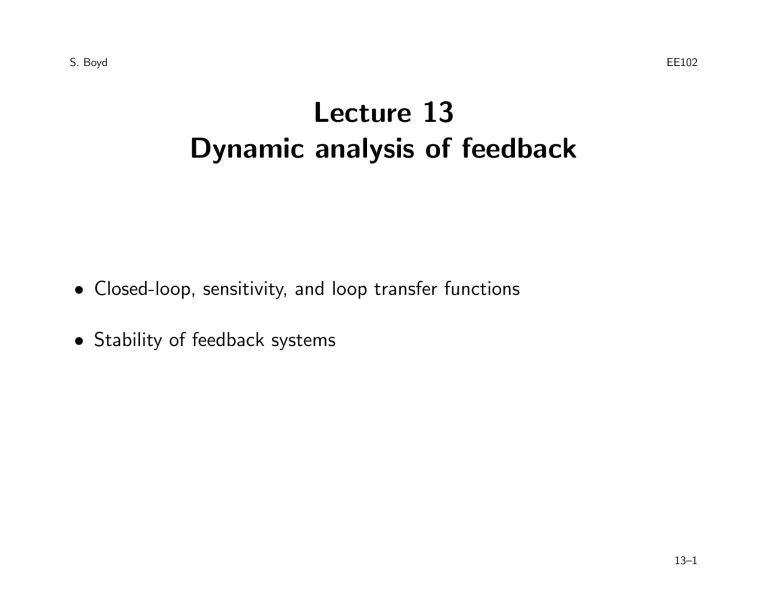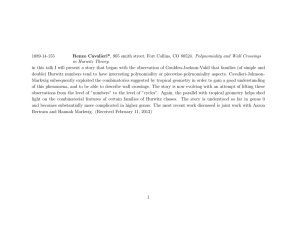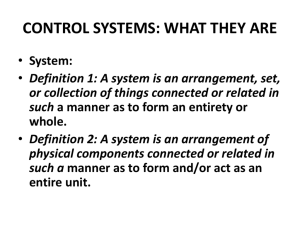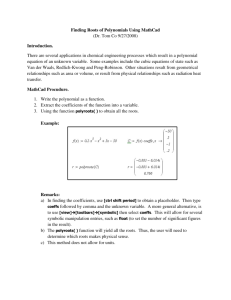Lecture 13 Dynamic analysis of feedback
advertisement

S. Boyd EE102 Lecture 13 Dynamic analysis of feedback • Closed-loop, sensitivity, and loop transfer functions • Stability of feedback systems 13–1 Some assumptions we now assume: • signals u, e, y are dynamic, i.e., change with time • open-loop and feedback systems are convolution operators, with impulse responses a and f , respectively u e ∗a y PSfrag replacements ∗f Dynamic analysis of feedback 13–2 feedback equations are now: y(t) = Z t a(τ )e(t − τ ) dτ, e(t) = u(t) − 0 Z t f (τ )y(t − τ ) dτ 0 • these are complicated (integral equations) • it’s not so obvious what to do — current input u(t) affects future output y(t̄), t̄ ≥ t Dynamic analysis of feedback 13–3 Feedback system: frequency domain take Laplace transform of all signals: Y (s) = A(s)E(s), E(s) = U (s) − F (s)Y (s) eliminate E(s) (just algebra!) to get Y (s) = G(s)U (s), G(s) = A(s) 1 + A(s)F (s) G is called the closed-loop transfer function . . . exactly the same formula as in static case, but now A, F , G are transfer functions Dynamic analysis of feedback 13–4 we define • loop transfer function L = AF • sensitivity transfer function S = 1/(1 + AF ) same formulas as static case! for example, for small δA, we have δA δG ≈S G A (but these are transfer functions here) Dynamic analysis of feedback 13–5 what’s new: L, S, G • depend on frequency s • are complex-valued • can be stable or unstable thus: • “large” and “small” mean complex magnitude • L (or G or S) can be large for some frequencies, small for others • step response of G shows time response of the closed-loop system Dynamic analysis of feedback 13–6 Example feedback system with 105 , A(s) = 1 + s/100 F = 0.01 • open-loop gain is large at DC (105) • open-loop bandwidth is around 100 rad/sec • open-loop settling time is around 20msec Dynamic analysis of feedback 13–7 closed-loop transfer function is G(s) = 1+ 105 1+s/100 105 0.01 1+s/100 99.9 = 1 + s/(1.001·105) • G is stable • closed-loop DC gain is very nearly 1/F • closed-loop bandwidth around 105 rad/sec • closed-loop settling time is around 20µsec . . . closed-loop system has lower gain, higher bandwidth, i.e., is faster Dynamic analysis of feedback 13–8 103 103 , so |L(jω)| = p loop transfer function is L(s) = 1 + s/100 1 + (ω/100)2 4 10 3 |L(jω)| 10 2 10 1 10 0 PSfrag replacements 10 −1 10 1 10 2 10 3 10 4 ω 10 5 10 6 10 • loop gain larger than one for ω < 105 or so ⇒ get benefits of feedback for ω < 105 • loop gain less than one for ω > 105 or so ⇒ don’t get benefits of feedback for ω > 105 Dynamic analysis of feedback 13–9 sensitivity transfer function is S(s) = 1 + s/100 1001 + s/100 0 10 −1 |S(jω)| 10 −2 10 −3 10 PSfrag replacements −4 10 1 10 2 10 3 10 4 ω 10 5 10 6 10 • |S(jω)| ¿ 1 for ω < 104 (say) • |S| ≈ 1 for ω > 105 or so Dynamic analysis of feedback 13–10 Thus, e.g., for small changes in A(0), A(j105) ¯ ¯ ¯ ¯ ¯ ¯ ¯ δG(0) ¯ ¯ ≈ 10−3 ¯ δA(0) ¯ , ¯ ¯ A(0) ¯ ¯ G(0) ¯ Dynamic analysis of feedback ¯ ¯ ¯ ¯ ¯ δG(j105) ¯ ¯ δA(j105) ¯ ¯ ¯ ¯ ¯ ¯ G(j105) ¯ ≈ ¯ A(j105) ¯ 13–11 Example (with change of sign) 105 , F = 0.01 now consider system with A(s) = − 1 + s/100 (note minus sign!) closed-loop transfer function is G(s) = 100.1 1 − s/(0.999·105) looks like G found above, but is unstable • in static analysis, large loop gain ⇒ sign of feedback doesn’t much matter • dynamic analysis reveals the big difference a change of sign can make Dynamic analysis of feedback 13–12 Heater example: dynamic analysis PSfrag replacements proportional controller of lecture 12, 70◦F P Tdes Tamb D α(s) T Plant k e Controller with dynamic model of plate: α(s) = Dynamic analysis of feedback 1 (1 + 0.1s)(1 + 0.2s)(1 + 0.3s) 13–13 step response of α(s) PSfrag replacements 1 0.8 0.6 0.4 0.2 0 −0.2 0 0.5 1 1.5 2 2.5 t (quite realistic; takes about 1 sec to heat up) Dynamic analysis of feedback 13–14 Let’s assume • Tamb = 70◦F • Tdes = 150◦F (actually doesn’t matter) • D is a unit step, i.e., for t ≥ 0 a disturbance power of 1W is applied • for t < 0 system is in static steady-state (with T = Tdes) ⇒ have an LTI system from D to temperature error e; transfer function is α(s) 1 + kα(s) step response gives temperature error resulting from unit step disturbance power Dynamic analysis of feedback 13–15 k=0 1 e(t) 0.8 PSfrag replacements 0.6 k=1 0.4 k=3 0.2 k = 10 0 −0.2 0 0.5 1 1.5 2 2.5 t Dynamic analysis of feedback 13–16 3 2 k=0 e(t) 1 PSfrag replacements k = 12 0 −1 −2 −3 0 k = 15 0.5 1 1.5 2 2.5 3 3.5 4 4.5 5 t Dynamic analysis of feedback 13–17 • closed-loop system can exhibit oscillatory response • for k < 10 (approximately) this transfer function is stable; for k > 10 (approximately) it is unstable • when stable, step response settles to DC gain, 1/(1 + k) • stability requirement limits how large proportional gain (hence loop gain) can be these are general phenomena Dynamic analysis of feedback 13–18 Design: choice of k involves tradeoff of static sensitivity, 1/(1 + k), versus dynamic response • k < 1 (or so) ⇒ closed-loop system not much better than open-loop • k > 5 (or so) ⇒ undesirable oscillatory response • k > 10 (or so) ⇒ very undesirable instability . . . here, maybe k = 2 or 3 is about right Let’s do some analysis . . . transfer function from D to e is 1 α(s) = 1 + kα(s) (1 + 0.1s)(1 + 0.2s)(1 + 0.3s) + k Dynamic analysis of feedback 13–19 its poles are the roots of the polynomial (1 + 0.1s)(1 + 0.2s)(1 + 0.3s) + k, which of course depend on k k 0 1 3 10 12 15 Dynamic analysis of feedback poles −10.0, −12.5, −14.6, −18.3, −19.1, −20.0, −5.00, −3.33 −2.94 ± 4.26j −1.86 ± 6.49j ±10.0j +0.36 ± 10.7j +0.83 ± 11.5j 13–20 poles are often plotted on complex plane: 20 k=0 k=3 k = 15 15 10 Imag part 5 0 −5 PSfrag replacements −10 −15 −20 −20 −15 −10 −5 0 5 10 15 20 Real part called root locus plot of (1 + 0.1s)(1 + 0.2s)(1 + 0.3s) + k Dynamic analysis of feedback 13–21 Checking stability when is H(s) = b(s)/a(s) stable? i.e., when do all roots of the polynomial a have negative real parts (such polynomials are called Hurwitz) if a is already factored, as in a(s) = α(s − p1)(s − p2) · · · (s − pn), we just check <(pi) < 0 for i = 1, . . . , n what if we are given the coefficients of a: a(s) = a0 + a1s + a2s2 + · · · + ansn Dynamic analysis of feedback 13–22 if the ai’s are specific numbers, we can easily factor a numerically (using a computer), then check but what if the coefficients involve parameters, as in a(s) = (1 + 0.1s)(1 + 0.2s)(1 + 0.3s) + k can we get the roots pi in terms of the coefficients ai? . . . an old problem • there are analytical formulas for the roots of a polynomial, for degrees 1, 2, 3, and 4 (they are complicated for third and fourth degree) • there are no analytical formulas for the roots of a polynomial of degree ≥ 5 (a famous result of Galois) Dynamic analysis of feedback 13–23 still, it turns out that we can express the Hurwitz condition as a set of algebraic inequalities involving the coefficients, using Routh’s method (1870 or so) • very useful 50 years ago, even for polynomials with specific numeric coefficients • only important nowadays for polynomials with parameters Dynamic analysis of feedback 13–24 we assume that an = 1 (if not, divide a(s) by an; doesn’t affect roots) so we have a(s) = a0 + a1s + · · · + an−1sn−1 + sn Fact: a is Hurwitz ⇒ a0 > 0, . . . , an−1 > 0 to see this, write a in real factored form: a(s) = a0 + a1s + · · · + an−1sn−1 + sn = q Y i=1 (s − pi) · r Y (s2 − 2σis + σi2 + ωi2) i=1 pi are the real roots, σi ± jωi are the complex roots of a Hurwitz means pi < 0 and σi < 0, so each term is a polynomial with positive coefficents a is a product of polynomials with all positive coefficients, hence has all positive coefficients the converse is not true: e.g., a(s) = s3 + s2 + s + 2 has roots −1.35, +0.177 ± 1.2j, so it’s not Hurwitz Dynamic analysis of feedback 13–25 Hurwitz conditions (obtained from Routh’s method or formulas for roots) • Degree 1: a0 + s is Hurwitz ⇔ a0 > 0 • Degree 2: a0 + a1s + s2 is Hurwitz ⇔ a0 > 0, a1 > 0 • Degree 3: a0 + a1s + a2s2 + s3 is Hurwitz ⇔ a0 > 0, a1 > 0, a2 > 0, a2 a1 > a 0 • Degree 4: a0 + a1s + a2s2 + a3s3 + s4 is Hurwitz ⇔ a0 > 0, a1 > 0, a2 > 0, a3 > 0, Dynamic analysis of feedback 13–26 a3 a2 > a 1 , a1a2a3 − a23a0 > a21 for degree ≥ 5, conditions get much more complex • you can find them via Routh’s method, if you need to (you probably won’t) • they consist of inequalities involving sums & products of the coefficients Dynamic analysis of feedback 13–27 Application: for what values of proportional gain k is our example, the plate heating system, stable? I.e., for what values of k is a(s) = (1 + 0.1s)(1 + 0.2s)(1 + 0.3s) + k = 0.006(167(k + 1) + 100s + 18.3s2 + s3) Hurwitz? Hurwitz conditions are: 167(k + 1) > 0, 100 > 0, 18.3 > 0, 100 · 18.3 > 167(k + 1), which simplify to: −1 < k < 10 (we suspected this from our numerical studies) Dynamic analysis of feedback 13–28 Summary for LTI feedback systems, • formulas same as static case, but now A, F , L, S are transfer functions • hence are complex, depend on frequency s, and can be stable or unstable • stability requirement often limits the amount of feedback that can be used Dynamic analysis of feedback 13–29




